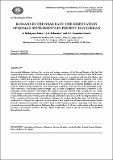Por favor, use este identificador para citar o enlazar a este item:
http://hdl.handle.net/10261/243006COMPARTIR / EXPORTAR:
 SHARE SHARE
 CORE
BASE CORE
BASE
|
|
| Visualizar otros formatos: MARC | Dublin Core | RDF | ORE | MODS | METS | DIDL | DATACITE | |

| Título: | Romans in the Near East: the orientation of Roman settlements in present-day Jordan |
Autor: | Rodríguez Antón, Andrea CSIC ORCID ; Belmonte, Juan Antonio; González-García, A. César CSIC ORCID | Palabras clave: | Orientation of Roman settlements Roman urbanism Ancient Jordan Eastern Roman Empire Limes Arabicus Decapolis |
Fecha de publicación: | 2016 | Editor: | University of the Aegean | Citación: | Mediterranean Archaeology and Archaeometry 16(4): 153-160 (2016) | Resumen: | An essential difference between the western and eastern provinces of the Roman Empire is the fact that sophisticated urban cultures had developed in Asia Minor and the Levant centuries before the Romans arrived. Underlying the Hellenized, and later Roman, veneer was a myriad of older local traditions and languages, which had an immense impact upon Roman religious tradition through elements such as the introduction of new religious practices. Following the path of previous studies, in this article we try to discern how Roman culture was inherited and adapted to the heterogeneous Eastern traditions and how it could be reflected in the architecture and urban layout, mainly in what concerns to the orientation of the urban structures. Considering ancient writings, such as those of Higynius Gromaticus (Constitutio, I), the orientation of these features could follow the position of certain celestial bodies, mainly the sun, which would imply a careful observation of the sky. Developing the lines of previous studies on the orientation of Roman settlements in the western part of the Empire (González-García et al., 2014 & Rodríguez-Antón et al., 2016), a number of Roman cities and military settlements in modern-day Jordan, Syria and Palestine are analysed here. Through this approach, we try to obtain a first insight into whether their orientations looked towards astronomical positions and wether there existed common patterns comparing with those sites previously measured in Hispania or Britannia. This would help us to obtain a wider vision of Roman ritual practices, cosmovisions and how Roman culture could have evolved, spread and became assimilated through lands and time. | Descripción: | Société Européenne pour l'Astronomie dans la Culture (SEAC 2015) Conference - "Astronomy in Past and Present Cultures" (November 2015 - Rome, Italy). | Versión del editor: | https://doi.org/10.5281/zenodo.220914 | URI: | http://hdl.handle.net/10261/243006 | DOI: | 10.5281/zenodo.220914 | ISSN: | 2241-8121 | E-ISSN: | 1108-9628 |
| Aparece en las colecciones: | (INCIPIT) Artículos |
Ficheros en este ítem:
| Fichero | Descripción | Tamaño | Formato | |
|---|---|---|---|---|
| Romans_Near_East.pdf | 485,49 kB | Adobe PDF |  Visualizar/Abrir |
CORE Recommender
SCOPUSTM
Citations
8
checked on 22-abr-2024
WEB OF SCIENCETM
Citations
7
checked on 17-feb-2024
Page view(s)
163
checked on 23-abr-2024
Download(s)
109
checked on 23-abr-2024
Google ScholarTM
Check
Altmetric
Altmetric
Este item está licenciado bajo una Licencia Creative Commons

